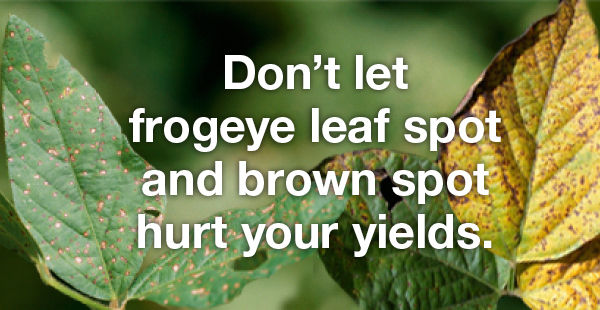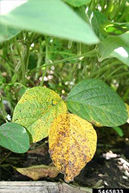Prevent Leaf Blights from Reducing Your Yield Potential
May 27, 2021

Pod set and pod fill are critical periods of development and yield potential in soybeans. Reducing plant stress during these stages is beneficial. While nothing can be done to control the weather, foliar fungicide applications are an option for disease management. Septoria brown spot and frogeye leaf spot are two common foliar diseases that can infect a soybean crop, severely diminishing yield potential. With proper identification and management, damage to yield potential can be minimized.
Septoria Brown Spot

Septoria brown spot (Septoria glycines) is a common soybean disease in the Midwest and is associated with wet weather. Septoria brown spot causes small, angular or circular brown and red spots on unifoliate and lower trifoliate leaves. This fungal disease overwinters in soybean debris and is more likely to be an issue in continuous and minimum tillage soybean fields. During rain events, spores are splashed from the debris up into the lower soybean canopy, where they are able to infect and cause Septoria brown spot symptoms. The disease usually appears on the lower section of the plant, but under warm, wet conditions, the disease may travel up through the plant. Although infection can occur at any stage of soybean development, brown spot often appears after flowering. Hot, dry weather generally stops the spread of the pathogen.
Frogeye Leaf Spot

Frogeye leaf spot is a common problem in the southern and central U.S. and can occur in some areas of the upper Midwest. This disease can cause severe defoliation during warm, humid weather. Symptoms of frogeye leaf spot are most visible and typically seen on young leaves but can also occur on stems, leaves, pods and seeds. This disease is fairly easy to recognize once you know what to look for. Initial symptoms appear as small dark spots on the leaves. The spots are angular with light gray centers and distinct purple to red-brown margins. Spores will be produced from leaf lesions, and secondary infections will continue as long as weather conditions remain conducive. In severe cases, disease can cause premature leaf drop and spread to pods and stems.
Protect your Soybean Fields with Delaro® Complete
Timely foliar fungicide applications can help protect soybean plants from foliar fungal diseases. Delaro® Complete Fungicide offers multiple modes of action to protect the yield potential of your high-yielding soybean crop from several foliar fungi including Septoria brown spot and frogeye leaf spot. Unlike other corn and soybean fungicides, Delaro Complete Fungicide delivers a best-in-class residual efficacy from all three active ingredients.
What is Delaro® Complete Fungicide and How does it work?
Delaro® Complete contains three active ingredients. The first, fluopyram, is a group 7, or SDHI, which has activity on diseases including frogeye leaf spot, white mold, and Septoria brown spot and offers plant health benefits. The second, prothioconazole, is a group 3, or triazole, which has a very broad and deep spectrum of disease control and activity. The third, trifloxystrobin, is a group 11, or strobilurin, that shows preventative activity on many diseases, and also offers plant health benefits.
The three active ingredients within Delaro Complete Fungicide offer individual, unique ways of working that protect crop yield and extend its protection. Delaro Complete Fungicide diffuses in and on the waxy surface of the plant. It then expands protection across the plant's exterior by moving via surface moisture, such as dew. Within the plant, Delaro Complete Fungicide is transported systemically throughout plant tissue for enhanced coverage.
Learn how Delaro Complete Fungicide can help protect against Frogeye Leaf Spot and Brown Spot
Follow all individual product label instructions for proper application timing, application volume, application equipment, and environmental and harvest interval precautions.
ALWAYS READ AND FOLLOW PESTICIDE LABEL DIRECTIONS. Performance may vary, from location to location and from year to year, as local growing, soil and weather conditions may vary. Growers should evaluate data from multiple locations and years whenever possible and should consider the impacts of these conditions on the grower’s fields.
Not all products are registered in all states and may be subject to use restrictions. The distribution, sale, or use of an unregistered pesticide is a violation of federal and/or state law and is strictly prohibited. Check with your local dealer or representative for the product registration status in your state. Bayer, Bayer Cross and Delaro® are registered trademarks of Bayer Group. All other trademarks are the property of their respective owners. ©2021 Bayer Group. All rights reserved.
Sources:
Dorrance, A. and Mills, D. 2011. Frogeye leaf spot of soybean. The Ohio State University Extension publication AC-53-10. http://ohionline.osu.edu. Malvick, D. Septoria brown spot. Crop Diseases. University of Minnesota Extension. www. Extension.umn.edu/Agriculture/crop-diseases/soybean/brownspot.html. Web sources verified 04/12/2021